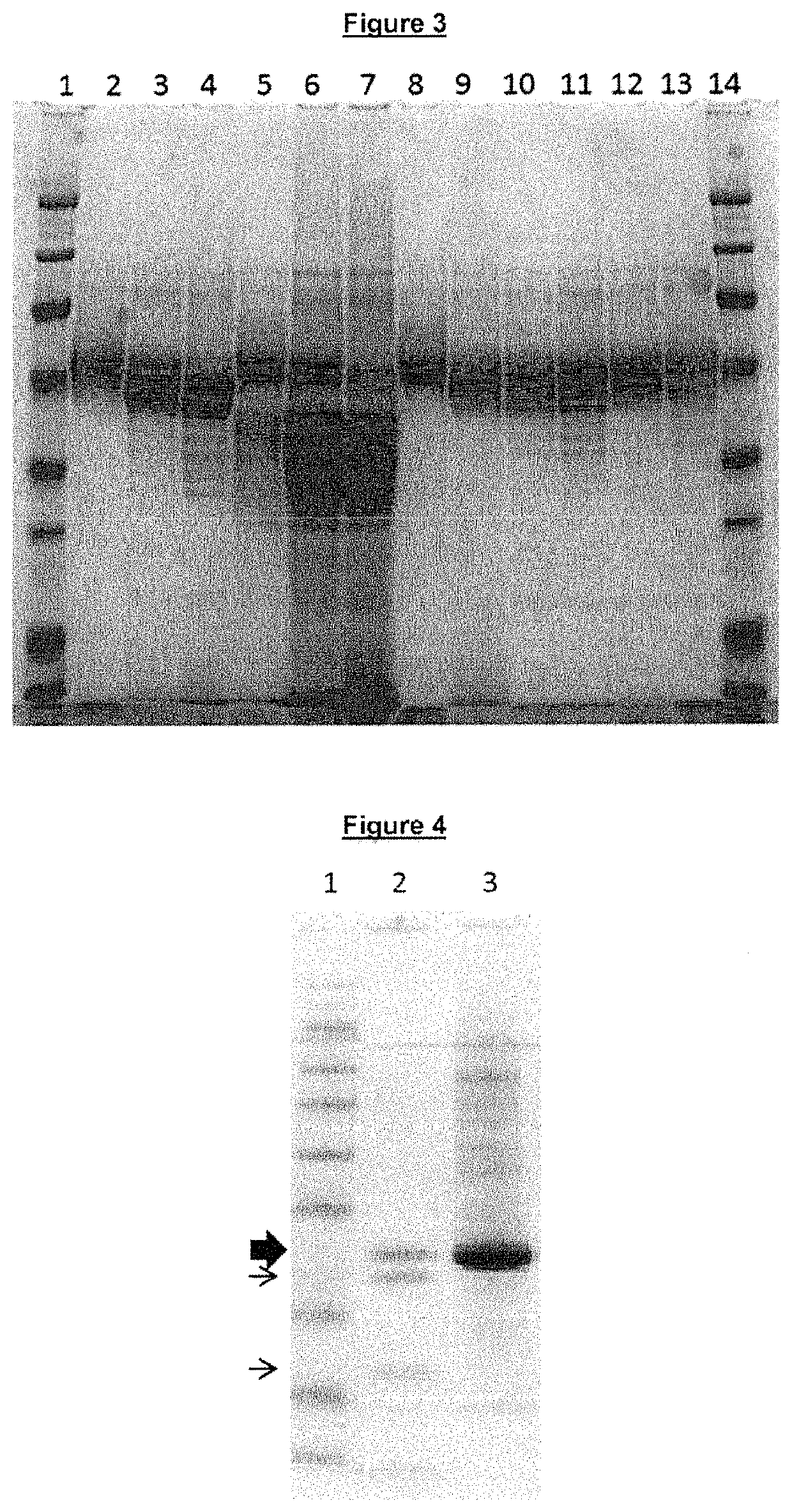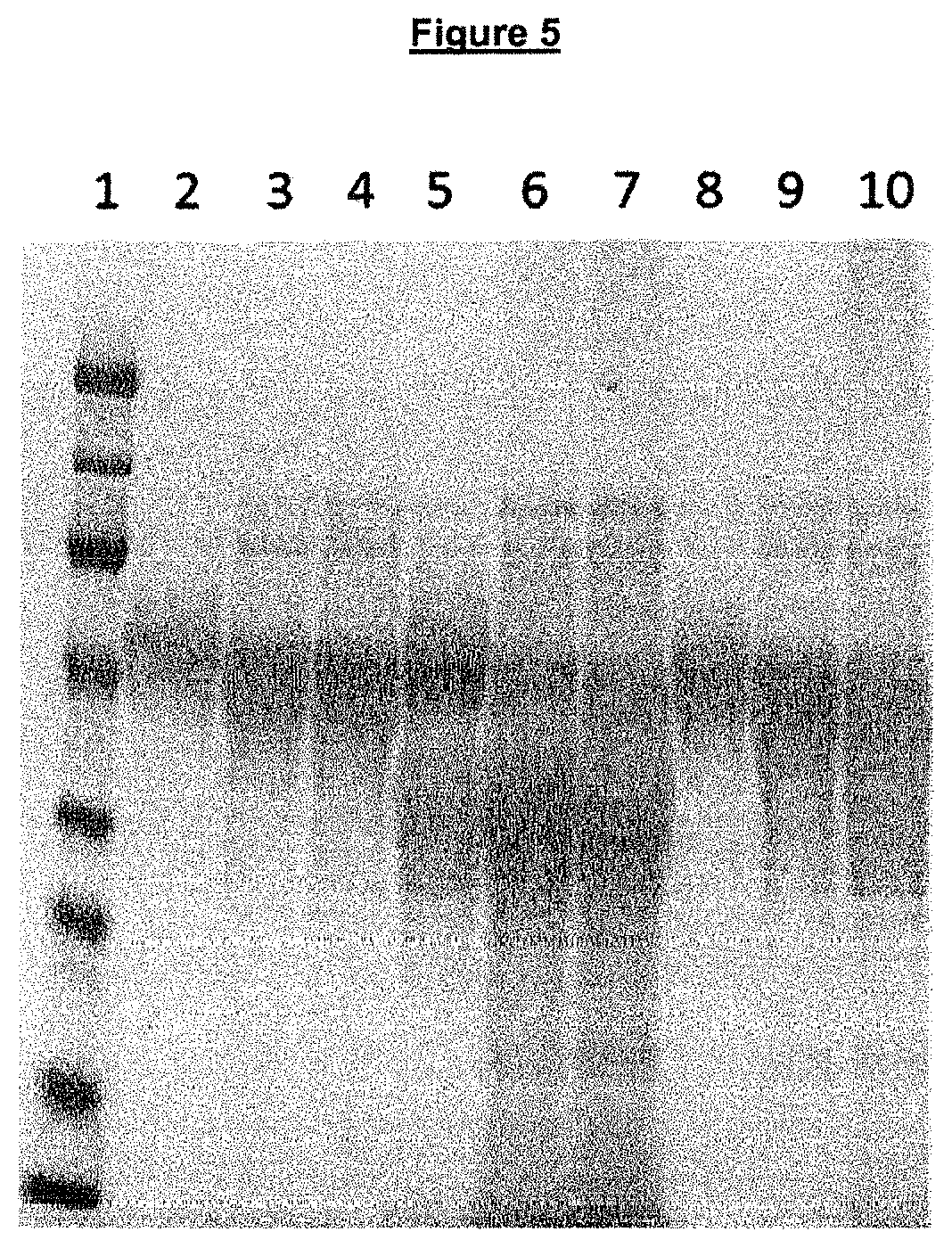Regulated PepC expression
a technology of pepc and expression regulation, which is applied in the field of recombinant fungal host cells, can solve the problems of severe impeded cell sporulation ability,
- Summary
- Abstract
- Description
- Claims
- Application Information
AI Technical Summary
Benefits of technology
Problems solved by technology
Method used
Image
Examples
example 1
Construction of the A. oryzae PniaD-pepC Strain, MLxN56
Construction of amdS Deleted A. oryzae Strain, MT3625
[0159]For deletion of the A. oryzae amdS gene a plasmid denoted pMT3536 was constructed in the following way: By PCR with the primers B2103F03 and B2103F04 on A. oryzae genomic DNA a 2654 bp DNA fragment was amplified containing the entire amdS coding region, including 352 bp upstream sequences and 348 bp downstream sequences. At the same time restriction sites were added (a SpeI sites 5′ to the amdS gene and a HindIII sites at the 3′ to the amdS gene) at the end of the amplified DNA. The 2654 fragment was cloned into the pCR-4 Blunt-TOPO vector according to the manufacturers instruction, thereby creating plasmid pJaL617.
[0160]The amdS gene was isolated as a 2648 bp SpeI-HindII fragment from pJaL617 and cloned into the corresponding restriction sites in plasmid pJaL575, thus creating plasmid pJaL619 containing the A. oryzae amdS gene and the Herpes simples virus thymidine kina...
example 2
Construction of Aspergillus Expression Plasmids
[0184]The plasmid pCOIs1126 was cut with AfeI and AatII. The 5615 bp fragment was purified and then blunt ended with Klenow polymerase. The fragment was then ligated and the resulting plasmid was named pCOIs1150.
[0185]First a PCR fragment was amplified using pCOIs1124 as the template and using the primer pair P801 and P802. Second another PCR fragment was amplified using pCOIs1124 as the template and using the primer pair P803 and P804. The two PCR fragments were fused using SOE-PCR and the primer pair P801 and P804. The SOE-PCR fragment was inserted in pCOIs1150 linearized with PvuII using the In-Fusion kit according to the manufactory instructions. The resulting plasmid was named pCOIs1151.
[0186]A PCR fragment was amplified using pCOIs1124 as the template and using the primer pair P805 and P806. The amplified PCR fragment was In-Fusion cloned into pCOIs1151 linearized with AscI. The resulting plasmid was named pCOIs1152.
[0187]A PCR fr...
example 3
Lipase Expression in A. oryzae with Native vs. niaD pepC-promoter
Construction of a Candida antarctica Lipase B Expression Plasmid, pMLxN31.
[0196]The Candida antarctica lipase B coding region was amplified by PCR with primer MLxn20 and MLxn21 from plasmid pMT1335, thus providing a 1067 bp DNA fragment. In this amplification there was added 20 bp 5′ to the lipase coding region and 18 bp 3′ to the lipase coding region in order to prepare it for In-Fhusion® cloning (Clontech Inc. USA). The plasmid pCOIs1198 was digested with NotI and AsiAI and the resulting 9684 bp fragment was purified from a 1% agarose gel band. The two fragments of 9684 bp and 1067 bp were mixed and spliced together by In-Fhusion® PCR. This generated an Aspergillus expression plasmid for the Candida antarctica lipase B, pMLxN31.
Candida antarctica Lipase B Expression in Aspergillus oryzae Strains
[0197]The Aspergillus oryzae strains RUNG237 and MLxN56 were transformed with the expression plasmid pMLxN31 as described un...
PUM
| Property | Measurement | Unit |
|---|---|---|
| pH | aaaaa | aaaaa |
| pH | aaaaa | aaaaa |
| concentration | aaaaa | aaaaa |
Abstract
Description
Claims
Application Information
 Login to View More
Login to View More - R&D
- Intellectual Property
- Life Sciences
- Materials
- Tech Scout
- Unparalleled Data Quality
- Higher Quality Content
- 60% Fewer Hallucinations
Browse by: Latest US Patents, China's latest patents, Technical Efficacy Thesaurus, Application Domain, Technology Topic, Popular Technical Reports.
© 2025 PatSnap. All rights reserved.Legal|Privacy policy|Modern Slavery Act Transparency Statement|Sitemap|About US| Contact US: help@patsnap.com



